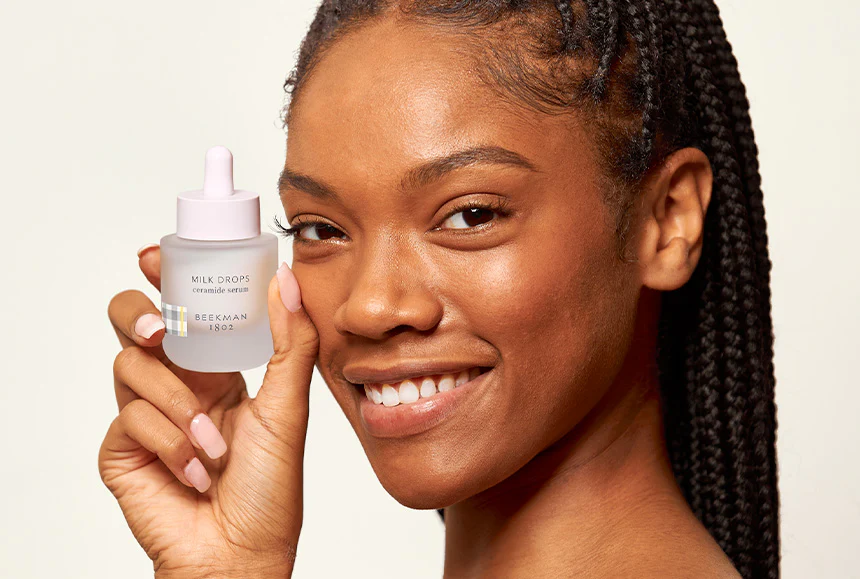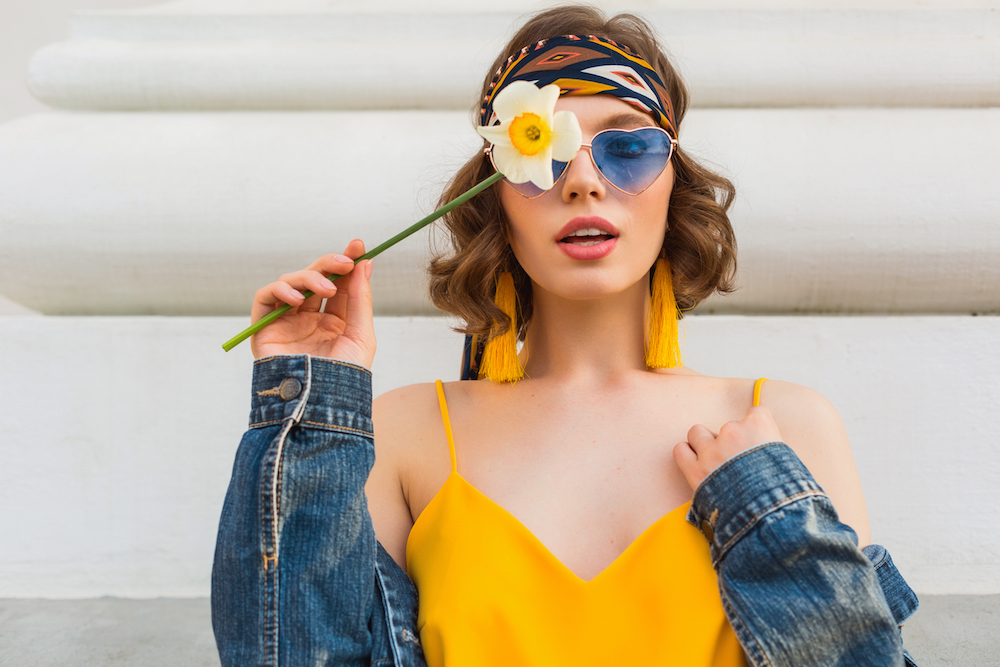Why Curtain Bangs Are Taking Over Hair Trends
Curtain bangs have seen a 600% increase in Google searches over the past two years, making them one of the most sought-after hair trends globally. This face-framing fringe style offers the perfect blend of vintage charm and modern versatility.
Quick Answer: What Are Curtain Bangs?
- Definition: Soft, parted bangs that sweep to each side like curtains
- Shape: Shorter in the center, longer at the temples
- Origins: 1960s-70s icons like Brigitte Bardot and Jane Birkin
- Maintenance: Low – trim every 4-6 weeks vs. 2-3 weeks for blunt bangs
- Versatility: Works with all face shapes and hair textures when cut properly
Unlike harsh, straight-across bangs, curtain bangs create a softer frame around your face. They’re nicknamed the “gringe” – a grown-out fringe that looks intentionally effortless.
“Curtain bangs give off a vibe of summer simplicity while elevating your entire look,” says celebrity hairstylist Xavier Velasquez. This explains why 9 out of 10 stylists recommend them for all face shapes and hair types.
The trend has deep roots in 1960s and 1970s fashion, when icons like Brigitte Bardot made the wispy, center-parted fringe famous. Today’s version maintains that romantic, undone quality while being much easier to maintain than traditional bangs.

What Are Curtain Bangs?
Picture the soft, romantic fringe that made Brigitte Bardot a style icon in the 1960s – that’s exactly what curtain bangs are all about. These aren’t your typical straight-across bangs that sit rigidly on your forehead. Instead, they’re a beautifully soft, parted fringe that sweeps gracefully to each side of your face, just like curtains framing a window.
The magic of curtain bangs lies in their unique shape. They start shorter at the center (usually around your eyebrow level) and gradually get longer as they move toward your temples. This creates a gentle arc that naturally follows your face’s contours, giving you that effortlessly chic look that seems to work on everyone.

The style has serious vintage credentials. Brigitte Bardot made this shaggy, undone fringe famous on the French Riviera, while Jane Birkin perfected that “summer simplicity” vibe that still inspires hairstylists today.
Here’s how curtain bangs stack up against traditional blunt bangs:
| Feature | Curtain Bangs | Blunt Bangs |
|---|---|---|
| Shape | Parted, angled | Straight across |
| Length | Varies (shorter center, longer sides) | Uniform |
| Maintenance | Every 4-6 weeks | Every 2-3 weeks |
| Grow-out | Graceful blending | Awkward stages |
| Face shapes | All shapes | Limited suitability |
| Styling time | 5-10 minutes | 10-15 minutes |
Anatomy of Curtain Bangs
Think of curtain bangs as having their own special architecture. When you look at them head-on, they create an inverted ‘V’ shape – shortest at the bridge of your nose and longest at your cheekbones or jawline.
The center part is absolutely crucial here. It’s what allows the bangs to naturally fall to each side, creating that signature curtain effect that gives this style its name. Professional stylists create this look by carefully sectioning about an inch of hair from your hairline and cutting at just the right angle.
Curtain Bangs vs Other Bang Styles
Curtain bangs are in a league of their own when compared to other fringe styles. Micro bangs sit way above your eyebrows and create a bold, geometric statement but need trims every 2-3 weeks. Side-swept bangs get brushed to one side but don’t have that beautiful symmetrical, face-framing quality. Blunt bangs are cut straight across for a dramatic look but can be unforgiving depending on your face shape.
The real beauty of curtain bangs is how adaptable they are. Feeling polished for work? Style them sleek. Want that effortless weekend vibe? Just scrunch them with texturizing cream.
Who Can Wear Curtain Bangs? Face Shapes & Hair Types
Here’s the best news about curtain bangs: they’re like that friend who gets along with everyone. Celebrity stylists consistently tell us that when cut properly, curtain bangs work beautifully on virtually every face shape and hair texture.
The magic happens because curtain bangs create balance rather than competing with your natural features. Unlike blunt bangs that can clash with certain face shapes, the soft, angled nature of curtain bangs improves what you already have.
If you have a round face, curtain bangs become your secret weapon for creating length and definition. The center part and gradually longer sides help elongate your features while drawing attention to your cheekbones.
Square faces benefit from the softening effect of wispy, feathered ends. Those beautiful strong jawlines get a gentle contrast from the romantic, undone quality of curtain bangs.
For heart-shaped faces, curtain bangs are practically made for you. They help balance a wider forehead with a narrower chin by creating visual weight in the middle of your face.
And if you’re blessed with an oval face? You’ve hit the jackpot. This face shape can wear any variation of curtain bangs.
Now, let’s talk about real life. If you have oily skin or live an active lifestyle, you might worry about bangs looking greasy. Here’s the reality: bangs do absorb oil and sweat faster than the rest of your hair. But this doesn’t mean curtain bangs are off-limits.
The solution is simple daily maintenance with dry shampoo or a lightweight refreshing mist. For those dealing with humidity and frizz, our guide on How to Fix Frizzy Hair in Humid Weather offers additional strategies.
Face-Shape Cheat Sheet
For round faces, request cheekbone-length curtain bangs with slightly longer edges. Square faces should ask for softer, wispier bangs that graze the jawline. Heart-shaped faces look stunning with fuller curtain bangs that start around pupil level and gradually taper toward the temples.
Curtain Bangs for Curly & Coily Textures
Curtain bangs work beautifully on curly and coily hair when your stylist understands how to work with your natural texture. The key difference is that curly curtain bangs need to be cut with your curl pattern in mind, cutting them slightly longer to account for shrinkage.
For curl definition, work with wet hair using curl cream and gel, then gently finger-coil to encourage that curtain shape. Air-drying often gives the most natural results. If you use heat, a diffuser on low temperature helps maintain curl definition while encouraging that soft, face-framing effect.
Cutting & Maintenance of Curtain Bangs
Getting perfect curtain bangs is like learning to ride a bike – it looks effortless once you know how, but there’s definitely a technique involved. While your social media feed might be full of DIY tutorials, we’re here to save you from a potential hair disaster.
The magic of curtain bangs starts with proper sectioning. Professional stylists create a triangle or horseshoe-shaped section from your front hairline, then establish that crucial center part. From there, they cut at a precise angle with the shortest point right at the center, gradually lengthening the pieces toward your temples.
The real artistry comes in the finishing touches. Point-cutting the ends creates that soft, feathered look that makes curtain bangs so flattering. Your stylist will also consider your unique hair growth patterns and any stubborn cowlicks before making that first cut.

DIY Curtain Bangs vs Professional Cut
Let’s be honest – we’ve all been tempted by those “cut your own bangs” videos at 2 AM. But here’s the thing: curtain bangs require precision that’s genuinely difficult to achieve without professional training and proper tools.
When you go the DIY route with kitchen shears, you’re gambling with your hair. Uneven lengths are surprisingly easy to create and surprisingly difficult to fix. Cut too short, and you’ll be wearing headbands for months.
Professional stylists bring years of experience and specialized tools to the table. They can customize your cut based on your specific face shape and hair texture. If you’re absolutely determined to do some at-home maintenance, limit yourself to tiny trims of obviously overgrown pieces.
Our Beauty Hacks for Busy Women includes some clever time-saving tips for keeping your fringe looking fresh between professional visits.
Trim Schedule & Graceful Grow-Out
Here’s some good news: curtain bangs only need trimming every 4-6 weeks, compared to the every-2-3-weeks schedule that blunt bangs demand. This lower maintenance is one of the biggest reasons why 80% of people find curtain bangs easier to live with long-term.
You’ll know it’s time for a trim when your bangs start covering your eyes during styling or when the center pieces grow past your eyebrows.
The best part about curtain bangs is how gracefully they grow out. Unlike blunt bangs that create that dreaded “awkward phase,” the graduated length means there’s no harsh line to deal with. As they grow, they naturally transform into face-framing layers that actually improve most haircuts.
Styling Curtain Bangs: Step-by-Step Methods
The magic of curtain bangs happens in the styling. Whether you’re rushing out the door or have time for a full routine, these face-framing beauties adapt to whatever your day demands.
You don’t need a professional setup to make your curtain bangs look salon-fresh. A medium round brush, blow dryer with a concentrator nozzle, and heat protectant spray cover the basics. Add some volumizing mousse for fine hair or texturizing spray for that effortless, lived-in texture.

The secret to great curtain bangs is working with your hair’s natural tendencies rather than forcing them into submission.
Everyday Blowout in 5 Minutes
This quick curtain bangs routine works for most hair types and fits into even the busiest mornings. Start with hair that’s about half dry – completely wet hair takes forever, while bone-dry hair won’t hold the style.
Apply your heat protectant first, then add volumizing mousse if your hair tends to be oily or a smoothing balm if frizz is your nemesis. Rough-dry your hair to about 70% dry, directing the airflow away from your face to create natural lift.
Here’s where the magic happens: wrap your curtain bangs around that medium round brush, lifting at the roots and directing the ends outward. Think of creating a gentle ‘C’ shape rather than forcing them stick-straight. Hit everything with cool air to lock in the style, then finish with a light mist of flexible hairspray.
The game-changer? Blow-dry your bangs in the opposite direction first, then sweep them into place. This prevents that flat, heavy look.
Curly & Textured Styling Hacks
For curly and textured hair, curtain bangs shine when you accept your natural texture instead of fighting it. The goal isn’t perfect symmetry – it’s enhancing what you’ve already got.

Start with soaking wet bangs and apply curl cream followed by defining gel. Finger coils or two-strand twists encourage your natural curl pattern while creating that curtain shape. Scrunch gently to remove excess water, then either diffuse on low heat or let them air dry completely.
Once everything’s dry, resist the urge to brush or comb. Instead, gently separate curls with your fingers for volume.
If you’re interested in maintaining healthy hair with gentler products, our guide to Chemical-Free Hair Products offers excellent alternatives to harsh styling products.
Active-Day Refresh & Oil Control
Let’s be honest – curtain bangs and sweaty workouts aren’t natural best friends. Those face-framing pieces absorb oil and sweat faster than you can say “hot yoga class.”
The trick is getting ahead of the problem. Apply dry shampoo to your bangs before exercising to create a barrier against oil absorption. Post-workout, a lightweight styling mist or another hit of dry shampoo revives limp bangs without requiring a full wash.
Curtain Bangs Inspiration & Variations
The beauty of curtain bangs lies in their incredible adaptability. Whether you’re channeling vintage glamour or modern minimalism, there’s a curtain bang variation that perfectly captures your personal style.
From the original Bardot-inspired wisps to bold, statement-making fringes, the options are truly endless. Bardot bangs remain the gold standard – those soft, feathered pieces that frame your face with romantic, undone texture.
For those who love texture and movement, shaggy curtain bangs blend seamlessly into layered cuts for that coveted rock-and-roll edge. Voluminous ’90s style curtain bangs are having a major moment – full, bouncy bangs that make a statement without being too dramatic.
Barely-there curtain bangs offer just a hint of fringe without the commitment. These wispy, minimal pieces are perfect for bang beginners. Above-brow curtain bangs maintain that signature angled shape while ending shorter than traditional versions.
For maximum versatility, long curtain bangs extend to graze your jawline. These pieces function more like face-framing layers, giving you the curtain bang effect while being incredibly easy to style.

Celebrity Curtain Bangs Inspiration
Celebrities have acceptd curtain bangs in countless ways, each bringing their own personality to this versatile trend.
Dakota Johnson has become synonymous with effortless curtain bangs. Her slightly messy, undone fringe perfectly complements her casual-chic style and proves that imperfection can be absolutely perfect.
Halle Berry shows us how beautifully curtain bangs work on shorter haircuts and textured hair. Her approach demonstrates that this trend isn’t limited to long, straight hair.
Sabrina Carpenter is the master of curtain bang versatility, switching between sleek, polished red-carpet looks and tousled, casual everyday styles.
Yara Shahidi beautifully showcases how curtain bangs improve natural curl patterns and textured hair. Her approach celebrates natural texture while creating that signature face-framing effect.
For endless style inspiration, Alexa Chung’s Instagram is pure gold. She’s been championing the effortless curtain bang look for years.
Try-On Without Commitment: Clip-In Curtain Bangs
Not quite ready to take the plunge with scissors? Clip-in curtain bangs are your perfect testing ground. These carefully crafted pieces let you experiment with the look without any permanent commitment.
Think of clip-in bangs as the responsible way to try a dramatic hair change. They’re hand-cut to mimic natural growth patterns and designed to blend seamlessly with your existing hairline. Plus, they’re available in 14 different shades.
Installing clip-in curtain bangs is simpler than you might think. Start by choosing a shade that matches your roots, create a clean middle part, and position the clip-in piece right at your front hairline. Secure it using the built-in clips, then brush everything together and style as one cohesive look.
The best part? If you love how you look, you can take the clip-ins to your stylist as a reference for your real cut.
Frequently Asked Questions about Curtain Bangs
Are curtain bangs low-maintenance?
This is probably the most common question we hear about curtain bangs, and the answer is a resounding yes! They’re honestly one of the most forgiving fringe styles you can choose.
Unlike blunt bangs that seem to grow overnight and look messy after just a few days, curtain bangs have a graceful, lived-in quality that actually improves as they grow. You’ll only need to book a trim every 4-6 weeks instead of the 2-3 week schedule that blunt bangs demand.
The real beauty lies in their styling flexibility. On busy mornings, you can literally just scrunch some texturizing cream into damp bangs and let them air-dry. They’ll naturally fall into that effortless, face-framing shape that looks intentional rather than neglected.
Even when your curtain bangs start getting a bit long, they don’t hit that awkward “covering your eyes” stage as quickly as other bang styles. Instead, they gradually transform into face-framing layers that many people actually prefer to the freshly-cut look.
How often should I trim curtain bangs?
Most professional stylists recommend trimming curtain bangs every 4-6 weeks to keep them looking their best. However, this isn’t a hard rule – your personal hair growth rate and style preferences make a big difference.
If you’re someone whose hair grows quickly, you might find yourself booking appointments closer to the 4-week mark. But if you prefer a more relaxed, grown-out look (which is totally on-trend), you can easily stretch it to 6-8 weeks between cuts.
The great news is that curtain bangs don’t have that harsh “deadline” feeling that comes with blunt bangs. When blunt bangs grow out, there’s usually a specific day when they suddenly look terrible. With curtain bangs, the transition is much more gradual and forgiving.
Some people even prefer their curtain bangs when they’re slightly overgrown because it creates that coveted “undone” texture that’s so popular on social media. The key is communicating with your stylist about whether you want a more polished or relaxed look.
Can I style curtain bangs without heat?
Absolutely! In fact, curtain bangs often look their most natural and appealing when you skip the heat styling altogether. This is especially true if you’re going for that effortless, “I woke up like this” vibe.
For straight to wavy hair, the process couldn’t be simpler. Apply a small amount of styling cream or lightweight mousse to damp bangs, create your center part with your fingers, and then just let them air-dry. The natural weight of your hair will help them fall into that perfect curtain shape.
If you have curly or textured hair, heat-free styling is often the best approach anyway. Use your favorite curl-defining products on soaking wet bangs, gently scrunch to remove excess water, and either air-dry completely or use a diffuser on the lowest heat setting.
The secret to great heat-free curtain bangs is working with your hair’s natural texture instead of fighting against it. This approach not only saves time in your morning routine but also keeps your hair healthier by avoiding daily heat damage.
Many people find that their curtain bangs actually look better without heat styling because it preserves the soft, natural movement that makes this style so appealing in the first place.
Conclusion
Curtain bangs have captured hearts worldwide for good reason – they’re the rare hairstyle trend that actually delivers on its promises. With their remarkable 600% surge in Google searches and glowing reviews from stylists everywhere, these face-framing beauties have proven they’re more than just a passing fad.
What makes curtain bangs so special? It’s their incredible ability to work with your natural features rather than against them. Whether you have a round face that benefits from their elongating effect, square features that soften with their wispy texture, or curly hair that looks amazing when styled with your natural pattern, there’s a curtain bang variation that fits your unique beauty.
The low-maintenance lifestyle these bangs offer is honestly refreshing in our busy world. No more racing to the salon every two weeks or wrestling with stubborn cowlicks every morning. With curtain bangs, you can literally roll out of bed, run your fingers through your fringe, and look effortlessly put-together.
From Brigitte Bardot’s timeless elegance to today’s fresh interpretations by style icons like Dakota Johnson, curtain bangs bridge the gap between vintage glamour and modern ease. They’re sophisticated enough for the boardroom yet relaxed enough for weekend coffee runs.
While DIY tutorials might be tempting, investing in a professional cut for your initial curtain bangs is worth every penny. A skilled stylist will customize the angle and length to complement your specific face shape and hair texture, setting you up for months of great hair days.
Ready to dive deeper into beauty and wellness wisdom? Explore our Beyond Beauty Lab wellness resources for more expert insights on achieving your most confident, radiant self while embracing clean beauty practices that nourish from the inside out.







